使用合适的开关稳压器实现高效、低轨噪和快速瞬态响应
投稿人:DigiKey 北美编辑
2025-06-26
在依赖低信号电平模拟电路的无线连接等应用以及采用低电源轨电压的数字设计中,DC 轨的质量是保持系统性能的关键。除了转换效率、输出精度、稳定性以及线路和负载调节外,DC 轨的质量还取决于其固有噪声和对动态负载变化的瞬态响应等因素。
不过,Analog Devices 的稳健型 Silent Switcher 系列经过多代发展,已经成为一种成熟的技术,只要应用得当,就能提供所需的低噪声 DC 输出和超快瞬态响应。
本文将重点介绍这些易于使用的高性能 DC/DC 开关稳压器,及其优势和所能解决的问题。本文将以 Analog Devices 的应用为例,说明如何最大限度地发挥这些开关稳压器的性能。
Silent Switcher 系列
Analog Devices 的 Silent Switcher 系列 DC/DC 开关稳压器现已发展到第三代。第一代产品 Silent Switcher 1 主要用于降低与开关稳压器相关的高频噪声。这一代产品同时具有三大优势:低电磁干扰(EMI)、高效率和高开关频率(适用于较小的相关器件)。
随后,Analog Devices 又推出了Silent Switcher 2。该产品保留了前代产品的功能,并增加了集成精密电容器,采用了更紧凑的外形,以及消除了对印刷电路板(PC 板)布局的敏感性。
第三代产品 Silent Switcher 3 继承了前两代产品的独特功能。该产品还具有快速瞬态响应和低频段超低噪声等优点(图 1)。
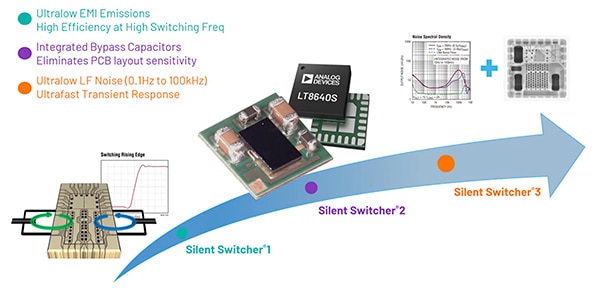 图 1:每一代 Silent Switcher DC/DC 稳压器都保留了上一代产品的特性和功能,并增加了新的特性和功能。(图片来源:Analog Devices)
图 1:每一代 Silent Switcher DC/DC 稳压器都保留了上一代产品的特性和功能,并增加了新的特性和功能。(图片来源:Analog Devices)
简单的 Switcher 噪声解决方案
为了实现前两代产品的低噪声特性,设计人员研究了多种噪声源,并探索了绕过、最小化甚至消除噪声源的创新方法。这需要采取多方面的方法。例如,开关模式电源的主要噪声源是电流的开关动作,而非流过稳态电流。在传统开关式稳压器拓扑中,有一个被称为热环路的电流路径。热环路是向空气中发射高频噪声的主要来源,造成 EMI。第一代 Silent Switcher DC/DC 稳压器创新性地将热回路分成两个对称的电流回路。这样就产生了两个极性相反的磁场,从而在很大程度上抵消了辐射噪声。
通过将输入电容器直接集成到 IC 封装中,Silent Switcher 2 最大限度地减少了关键的热回路。
该架构支持快速切换边沿,可在高频开关条件下实现高效率,同时保持良好的 EMI 性能。DC 输入电压 (VIN) 端的内部陶瓷电容器有助于保持较小的快速 AC 电流回路,从而进一步提高性能。Silent Switcher 架构还采用了专有的设计和封装技术,可在极高频率下最大限度地提高效率,使其能够通过 CISPR 25 5 类的峰值 EMI 限制。
此外,还采用了有源电压定位 (AVP) 技术,即输出电压取决于负载电流。轻载时,输出稳压值高于标称值,满载时低于标称值。对 DC 负载调节进行了调整,以提高瞬态性能并尽可能地降低输出电容器要求。
Silent Switcher 3 和瞬态响应
瞬态响应是指稳压器对负载突变做出响应的能力,已成为一个日益重要的参数。因此,第三代产品除了最大限度地降低低频噪声(10 Hz 至 100 kHz)外,还注重提供超快的瞬态响应。
信号处理器和片上系统 (SoC) 经常会出现突然变化的负载瞬态曲线,因此对瞬态响应的关注度越来越高。这种负载瞬态会对电源电压造成干扰,而这个参数对于高性能射频设计至关重要。例如,不同的电源电压会严重影响系统时钟频率。
因此,射频 SoC 通常会在负载瞬态期间应用消隐时间。在 5G 应用中,信息质量与瞬态期间的消隐期密切相关。因此,将负载瞬态对电源的影响降至最低将提高系统级性能。
为了实现这些目标,单片 Silent Switcher 3 器件采用了超高性能误差放大器设计,即使在激进补偿的情况下也能提供额外的稳定性。4 兆赫兹 (MHz) 的最大开关频率使该 IC 能够在固定频率峰值电流控制模式下,将控制环路带宽提升到 100 kHz 左右的范围。此外,多项创新技术还能减少阻碍瞬态响应的微妙因素:
负载分离——在典型设计中,1 V 负载包括发送和接收电路、本地振荡器 (LO) 和压控振荡器 (VCO)。在频分双工 (FDD) 运行期间,发送/接收负载的负载电流会发生突变。同时,LO 和 VCO 的负载是恒定,但要求高精度和低噪声。
这些器件的高带宽特性使设计人员能够通过第二个电感器 (L2) 分离动态负载和静态负载,从而从稳压器 IC 为两个关键的 1 V 负载组供电(图 2,上)。负载瞬态响应快,VOUT 偏差极小,且不会影响静态负载(图 2,下)。
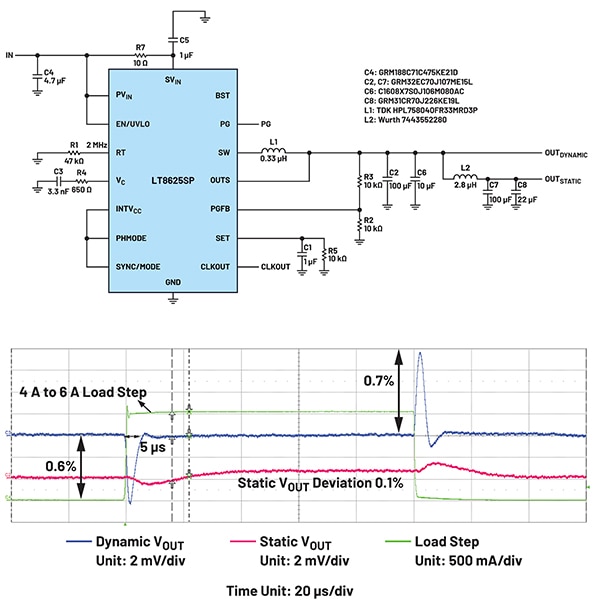 图 2:所示为 Silent Switcher 的应用电路,该电路利用电感器 (L2) 分离动态和静态射频负载,以提高性能(上图);负载瞬态响应快,VOUT 偏差最小,不会影响静态负载(下)。(图片来源:Analog Devices)
图 2:所示为 Silent Switcher 的应用电路,该电路利用电感器 (L2) 分离动态和静态射频负载,以提高性能(上图);负载瞬态响应快,VOUT 偏差最小,不会影响静态负载(下)。(图片来源:Analog Devices)
采用最小等效电感的后滤波——在时分双工 (TDD) 模式下,对噪声敏感的 LO 和 VCO 随着发送/接收模式的变化而加载和卸载。因此,由于所有负载都被视为动态负载,因此可以使用简化电路;与此同时,为了保持 LO 和 VCO 的低纹波和低噪声特性,需要进行更为关键的后滤波。
采用馈通模式的三端电容器可以以最小的等效电感实现充分的后滤波,从而保持负载瞬态的快速带宽(图 3,上)。馈通电容器与远程侧输出电容器共同构成两个额外的电感电容器 (LC) 滤波器级。所有电感均来自三端电容器的等效串联电感 (ESL),ESL 非常小且对负载瞬态的影响较小。馈通电容器增强了瞬态响应能力,同时将输出电压纹波降至最低(图 3,下)。
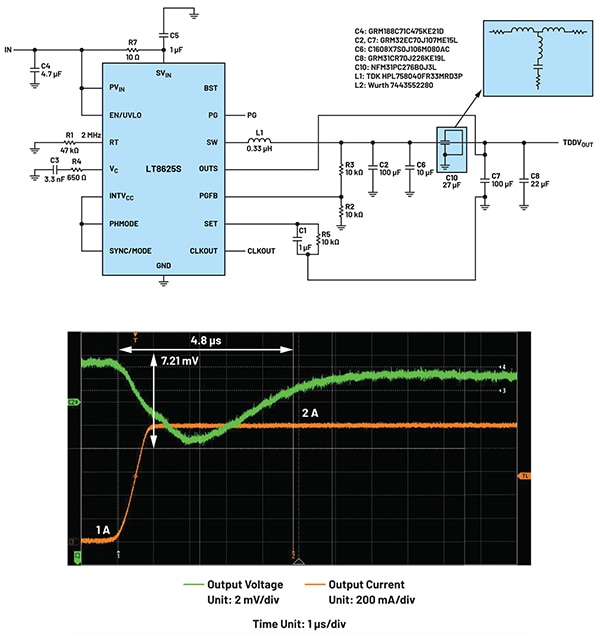 图 3:所示为一个用于动态/静态组合射频负载的应用电路,该电路使用一个三端馈通电容器(右上),以最小等效电感提供后滤波,从而保持负载瞬态的快速带宽。馈通电容器增强了瞬态响应,同时将输出电压纹波降至最低(下)。(图片来源:Analog Devices)
图 3:所示为一个用于动态/静态组合射频负载的应用电路,该电路使用一个三端馈通电容器(右上),以最小等效电感提供后滤波,从而保持负载瞬态的快速带宽。馈通电容器增强了瞬态响应,同时将输出电压纹波降至最低(下)。(图片来源:Analog Devices)
预充电——在某些情况下,信号处理单元采用通用 I/O (GPIO);此外,信号处理是按计划进行的,且预先知道瞬态事件。这种情况通常出现在一些 FPGA 电源设计中。在这些设计中,预充电信号的产生有助于电源的瞬态响应。
在一个典型的应用电路中(图 4,上),如果 FPGA 在实际负载之前产生一个预充电信号以提供偏置,则瞬态可使该器件有更多的时间来适应负载干扰,并将 VOUT 偏差和恢复降至最低(图 4,下)。
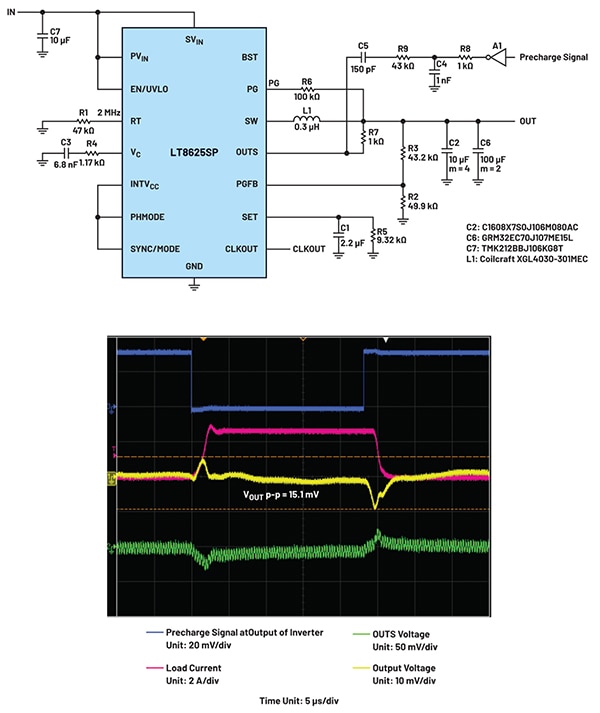 图 4:图中所示为向误差放大器负输入引脚 (OUTS) 输入的预充电信号,用以产生快速瞬态响应;稳压器的反馈受到预充电信号和负载瞬态的影响(下)。(图片来源:Analog Devices)
图 4:图中所示为向误差放大器负输入引脚 (OUTS) 输入的预充电信号,用以产生快速瞬态响应;稳压器的反馈受到预充电信号和负载瞬态的影响(下)。(图片来源:Analog Devices)
有源下垂——在波束成形器应用中(图 5,上),电源电压不断变化,以适应不同的功率水平。因此,对电源电压精度的要求通常为 5% 至 10%。在这种应用中,稳定性比电压精度更重要,因为在负载瞬态期间尽量缩短恢复时间可以最大限度地提高数据处理效率。下垂电路非常适合这种应用,因为下垂电压将会缩短甚至消除恢复时间(图 5,下)。
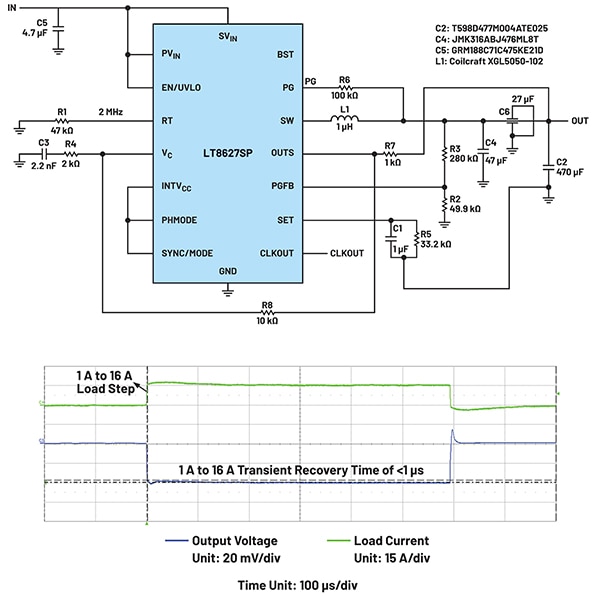 图 5:在 OUTS 和 VC 之间放置一个有源下垂电阻器 (R8),有助于实现快速瞬态恢复(上);可定制下垂瞬态响应,从而最大限度地缩短瞬态恢复时间(下)。(图片来源:Analog Devices)
图 5:在 OUTS 和 VC 之间放置一个有源下垂电阻器 (R8),有助于实现快速瞬态恢复(上);可定制下垂瞬态响应,从而最大限度地缩短瞬态恢复时间(下)。(图片来源:Analog Devices)
实施器件,验证创新
这些降噪和改善瞬态的概念已融入到单片式 Silent Switcher 3 系列器件中。这些器件支持广泛的电压和电流最大值,同时为用户提供不打折的灵活性和性能。例如,LT8622SAV#PBF(图 6,上)和LT8627SPJV#TRPBF(图 6,下) 这两款器件清楚地说明了这一点。
在电流和功率范围的较低端应用中,LT8622SAV#PBF 是一款 2 安培 (A) 连续输出转换器,采用 2.7 V 至 18 V 输入。该器件的输出电压范围为 0 V 至 VIN- 0.5 V,可通过一个电阻进行编程。其大部分输出电流范围内的效率至少为 90% ,最高可达 95% 。
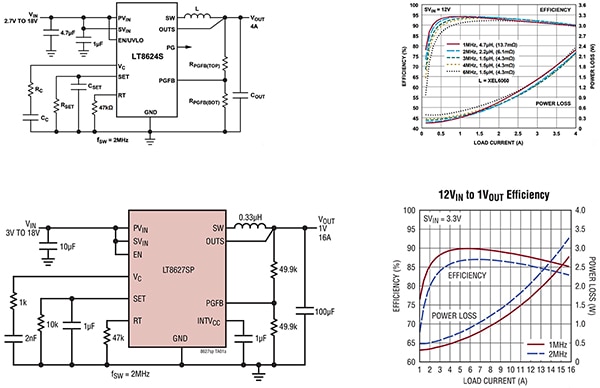 图 6:所示为典型应用配置中的 2 A LT8622 及其效率和功率损耗曲线(上)(注:原理图中的 LTC8624 与 LT8622 具有相同的曲线,但额定电流为 4 A);图中还给出了 16 A LT8627 的此类信息(下)。(图片来源:Analog Devices)
图 6:所示为典型应用配置中的 2 A LT8622 及其效率和功率损耗曲线(上)(注:原理图中的 LTC8624 与 LT8622 具有相同的曲线,但额定电流为 4 A);图中还给出了 16 A LT8627 的此类信息(下)。(图片来源:Analog Devices)
LT8622SAV#PBF 在开关稳压器中具有出色的低频(0.1 Hz 至 100 kHz)输出噪声性能,噪声有效值仅为 4 μVRMS。工作频率可调,同步频率为 300 kHz 至 6 MHz。该器件采用小型 20 引线 4 mm × 3 mm LQFN 封装。
16 A LT8627SPJV#TRPBF 是高功率版本,输入电压为 2.8 V 至 18 V,而其输出电压可通过电阻器在 0 至 VIN 到 0.5 V 之间调节。在 1 MHz 开关频率下,其效率超过 80% ,在中载高效区可达 90%。该器件的低频输出噪声性能与 2 A LT8622SAV#PBF 相同。
工作频率也可调,可在 300 kHz 至 4 MHz 范围内工作和同步,低于电流较低的同类产品。其封装是体积稍大的 24 引线 4 mm × 4 mm LQFN,背面裸露,可选配散热片。
结语
对于尤其是尖端射频领域的创新产品设计人员来说,既要求高效率,又必须具备低噪声以及对电源电压的快速瞬态响应能力。Analog Devices Silent Switcher 3 系列 DC/DC 稳压器是新一代高效单片式器件,针对多种应用中的噪声敏感性、动态负载瞬态性能进行了优化。

免责声明:各个作者和/或论坛参与者在本网站发表的观点、看法和意见不代表 DigiKey 的观点、看法和意见,也不代表 DigiKey 官方政策。









